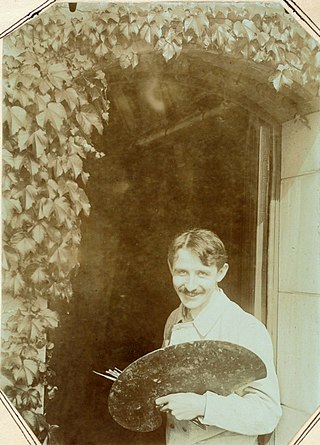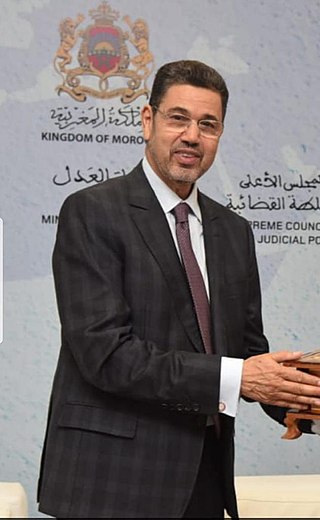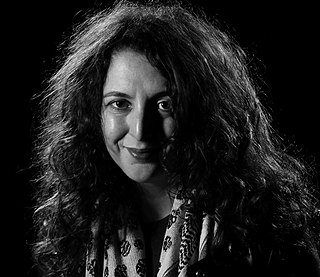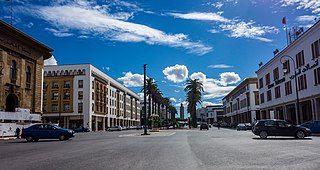Related Research Articles

There are around 56,986 km (35,409 mi) of roads in Morocco. In addition to 1,808 km (1,123 mi) of highways.
Nawal El Moutawakel is a Moroccan former hurdler, who won the inaugural women's 400 metres hurdles event at the 1984 Summer Olympics, and was the first Moroccan to win an Olympic gold. In 2007, El Moutawakel was named the Minister of Sports in the upcoming cabinet of Morocco.

Jacques Majorelle, son of the celebrated Art Nouveau furniture designer Louis Majorelle, was a French painter. He studied at the École des Beaux-Arts in Nancy in 1901 and later at the Académie Julian in Paris with Schommer and Royer. Majorelle became a noted Orientalist painter, but is most remembered for constructing the villa and gardens that now carry his name, the Majorelle Garden in Marrakech.

Abdallah Ibrahim was a Moroccan politician and a figure of the national movement and was the left-wing Prime Minister of Morocco between December 16, 1958, and May 20, 1960. He was the third Prime Minister of Morocco and served under king Mohammed V. He also served as the foreign minister from 1958 to 1960.
Bouchta El Hayani is a Moroccan artist who started his professional career in the 1970s. Since this period he has followed a successful path to become one of the leading and most famous Moroccan artists. First and foremost he is one of the rare Moroccan painters that perfectly master drawing techniques.

The General Directorate for National Security is the national police force of the Kingdom of Morocco. The DGSN is tasked with upholding the law and public order. It was founded on 16 May 1956 by King Mohammed V. It works alongside the Gendarmerie Royale and the Forces Auxiliaires.

The National Library of the Kingdom of Morocco is located in Rabat, Morocco, with a branch in Tetouan. The former Bibliothèque Générale was created in 1924. In 2003, it was renamed the "Bibliothèque nationale du Royaume du Maroc."

The General Directorate of Studies and Documentation is the foreign intelligence agency of Morocco, under authority of the Administration for National Defense. It is officially tasked with maintaining national security and the safety of national institutions.
The following is a timeline of the history of the city of Marrakesh, Morocco.

Miriem Bensalah-Chaqroun is a Moroccan businesswoman. She is CEO and vice-chair of Oulmes Mineral Water of Groupe Holmarcom. She is the president of Confédération générale des entreprises du Maroc from 2012 to 2018. She received the Wissam Al-Moukafa Al-Watania in 2013, the Order of Civil Merit in 2017 and the Legion of Honour in 2020.
The Yves Saint Laurent Museum in Marrakech is a museum dedicated to the fashion designer Yves Saint Laurent located in Marrakesh, Morocco.

M'hammed Abdenabaoui, born on 21 August 1954 in Khouribga, is a senior Moroccan magistrate and the former attorney general of the King at the Court of Cassation. In 2021, he was appointed by king Mohammed VI as the first President of the Court of Cassation and deputy President of the Supreme Council of the Judicial Power. He's a noted defender of the independence of the judiciary from the legislative and executive branches.

Youssef Ksiyer is a comedian, content creator, and multimedia host from Casablanca, Morocco. He is passionate about writing, interpretation, and comedy, creating content in Arabic, French, and English. When performing, he highlights current news as well as environmental problems.
Behind Closed Doors is a 2014 Moroccan drama film directed by Mohamed Bensouda and co-produced with Christophe Kay Kourdouly. The film stars Zineb Obeid with Karim Doukkali, Ahmed Saguia, and Amal Ayouch in supporting roles. The film explores the cultural taboo of sexual harassment through the perspective of Samira, a young married woman who faces unwanted advances from her office's new director. It premiered at the 2013 Marrakesh International Film Festival where two additional screenings were added due to popular demand. The critically acclaimed film went on to become Morocco's top selling movie in 2014 and screened worldwide.
Saâd Chraïbi is a Moroccan director and screenwriter.
Abdelkader Moutaa is a Moroccan actor known for his contributions to the Moroccan film and television industry.
A Muslim Childhood is a 2005 Moroccan film directed by Moumen Smihi. It was screened at the Marrakesh International Film Festival.
Selma Bargach is a Moroccan filmmaker.

Sonia Terrab is a Moroccan writer, filmmaker, and activist. Her work revolves around the status of women in Moroccan society, social hypocrisy regarding the body and sexuality, and Moroccan youth.

Avenue Mohammed V, sometimes referred to by its old name Avenue Dar al-Makhzen, is a major thoroughfare in downtown Rabat, Morocco. Its main section was created under the French Protectorate in Morocco and mostly developed between 1915 and 1932, when it was also known as Cours Lyautey. At the southern end of that section is the As-Sunna Mosque, whose history dates back to the 18th century like that of the nearby royal palace or Dar el-Makhzen.
References
- 1 2 "Casablanca: elles n'ont peur de personne en Harley Davidson". fr.le360.ma (in French). Retrieved 2019-03-20.
- 1 2 Acerra, Grégoire (2011-12-27). "Miss Moto Maroc : le premier moto-club féminin d'Afrique". Motomag, le site de Moto Magazine (in French). Retrieved 2019-03-20.
- ↑ ""Miss Moto Maroc", les Marocaines en Harley Davidson". Bladi.net (in French). Retrieved 2019-03-20.
- ↑ Renton, Constance (2017-04-08). "Miss Moto Maroc Celebrates Female Bikers in Morocco". Morocco World News. Retrieved 2019-03-20.
- 1 2 3 Silcox, John (2019-03-16). "A Muslim woman's place? In Casablanca, it could be burning rubber on a Harley…". The Guardian. ISSN 0261-3077 . Retrieved 2019-03-20.
- ↑ MATIN, LE. "Le Matin - Marrakech abritera la 2e édition de miss Moto Maroc". Le Matin (in French). Retrieved 2019-03-20.
- ↑ "Les bikeuses marocaines se donnent rendez-vous à Marrakech". Al HuffPost Maghreb (in French). 2016-03-08. Archived from the original on March 9, 2016. Retrieved 2019-03-20.
{{cite web}}: CS1 maint: unfit URL (link)